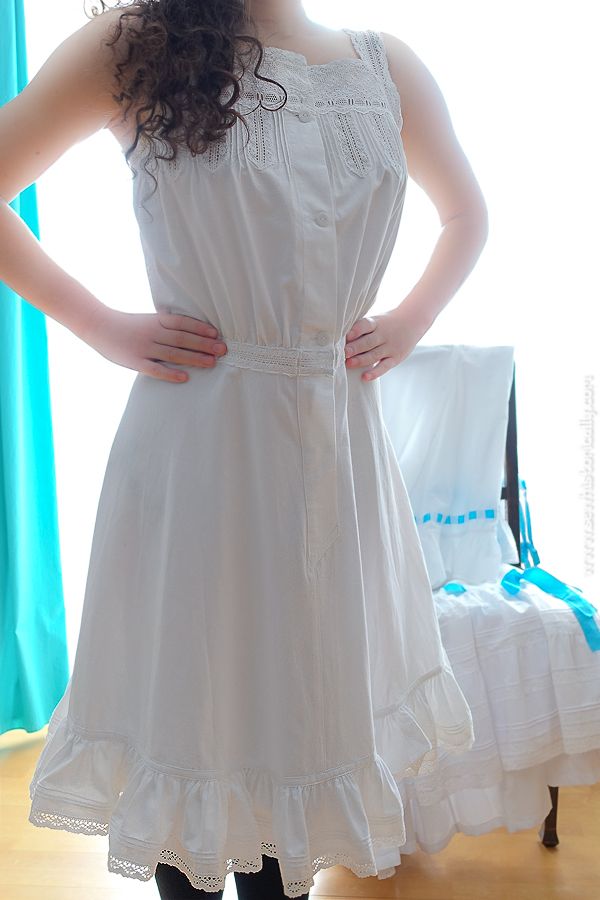This refashioned Edwardian lace slip was my Edwardian combination before! 😉 The Edwardian combination was one of my first Edwardian sewing projects so it wasn’t historically correct. The seams were just zigzagged, velvet trim was never used on Edwardian underwear and never in this way. On top of that, I also made a mistake when cutting out the combination suit so there was an ugly zigzagged join down the front of the drawers part. And because of all that I didn’t like it anymore and never wore it. But the fabric was still good. Therefore I decided to refashion it into something I’d like and wear!
Related: Edwardian Combination – The Before
Lace Scraps
The Edwardian slip is also a stash buster project: I made it to use up the lace scraps in my stash. All lace that I used is pure cotton lace: bobbin lace and eyelet lace. Most of the lace was from my grandma and only small pieces were left: Most lace scraps were only about 10cm (4″) long. I don’t like to throw away cotton lace if the lace is still good. So I joined the lace scraps with flat felled seams where necessary. And I planned the design so that I could use up almost all of the small lace pieces: so that there’s no lace leftover but that there’s also no waste.
I also didn’t have insertion lace for the lace inserts at the front of the slip. Therefore I used lace edging and stitched it together with overhand stitches by hand. Now it looks like insertion lace!
Related: 6 Ways How To Insert Lace
The lace insertion, lace yoke and lace shoulder straps are inspired by the the following antique Edwardian lace camisoles: 1906 camisole with lace insertion & lace shoulder straps, antique Edwardian camisole with lace insertion & lace shoulder straps and 1900s camisole with bobbin & eyelet lace yoke & shoulder straps.
I sewed most of the lace for the yoke and shoulder straps together with overhand stitches by hand. Even though lingerie in the Edwardian era was sewn on a sewing machine, lace was usually still attached with overhand stitches by hand!
Related: Edwardian Slip With Lace Inserts – History Bounding
And to embellish the ruffle at the hem, I used bobbin lace that was leftover from my refashioned short Edwardian petticoat.
Pintucks
I added pintucks at the back and sides of the slip. This was often done in the Edwardian era – like on this antique Edwardian camisole – to stiffen the slip so that the sides and back fit wrinkle-free under the clothes. While the short pintucks at the front create the fashionable Edwardian pouter pigeon shape.
‘The fullness at the top […] may be arranged by […] machine tucks. […] machine stitching taking the place of hand work wherever possible.’ (A Manual Of Home-Making, 1919) ‘Tucks of 1/8 inch in width may be run about three inches deep each side of the front laps, five or six tiny ones being made on each side, according to the amount of fullness to be taken in.’ (Clothing And Health. An Elementary Textbook Of Home Making, 1916)
I also added three rows of pintucks at the hem ruffle to embellish and stiffen the hem.

Edwardian Slip Inspirations
My refashioned Edwardian lace slip is inspired by antique Edwardian slips with a fitted waist like this one or this one.
Lace Waistband
After gathering the front part of the bodice, I finished the waist with leftover lace from the lace insertion. And because I didn’t have enough lace left, I used a self-fabric strip with pintucks at the back of the slip. I made the waistband like a drawstring so that I can thread a colored silk ribbon through if I want, similar to this antique Edwardian slip with a lace drawstring waist and pink silk ribbon or this 1900s chemise with a lace drawstring waist.
Button Closure
My Edwardian slip has a hemmed placket above the waist and an extension placket below the waist. I followed the instructions in this Edwardian sewing book to make the plackets.
‘A placket is an opening left in a garment for convenience in putting it on, the raw edges being finished to keep it from tearing or raveling’ (School Sewing Based On Home Problems, 1916).
The placket of my refashioned Edwardian lace slip is closed with three buttons and one snap at the lace yoke and one snap below the waist.
Seams
There are no raw edges inside the slip: all seams are flat felled seams and all raw edges are either finished with cotton tape or cotton bias binding.
And I finished the armhole with cotton bias facing before I embellished it with more lace.
‘Finish the armholes with bias strips of the material cut about 1″ wide […] Overhand lace on the edge of the arm-hole after it is faced’ (School Sewing Based On Home Problems, 1916).
Finishing Braid
I usually attach ruffles – like it was done in the Edwardian era – with a ‘receiving tuck’. But this time to save fabric I tried another Edwardian way to attach ruffles: This time I used ‘finishing braid’ to finish the raw edges. Finishing braid was pure cotton braid, either white or pastel colored, and plain or figured. I simply used white cotton tape.
Related: 5 Ways To Attach Ruffles
Hem Circumference
My refashioned Edwardian lace slip has a circle skirt with a straight-grain ruffle at the hem. The circle skirt part of the slip is 69″ (175cm) wide and the ruffle is 186″ (472cm) wide.


